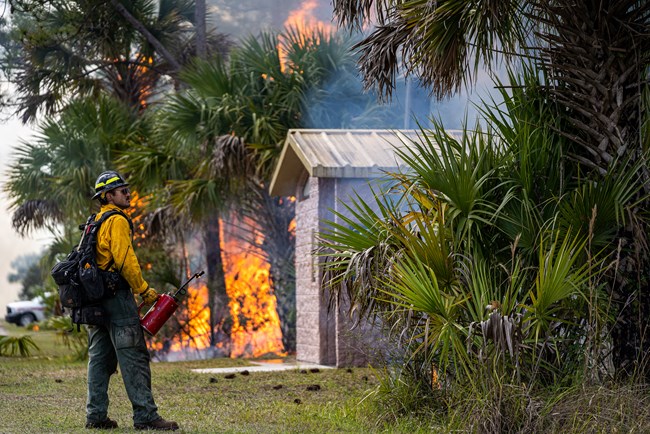Last updated: December 18, 2023
Article
Prescribed Fire: The best defense is a good offense

Michael Gue, South Florida Prescribed Fire Manager, NPS
South Florida Fire and Aviation (SFFA) is on the offensive in the fight against devastating wildfires. Through scientific design, strategic planning, and adaptive management, SFFA is conducting landscape level prescribed fire specifically designed to protect National Park Service (NPS) land, infrastructure, natural and cultural resources.
Throughout fiscal year 2023, SFFA implemented over 231,000 acres of fuels treatments across South Florida Parks and Preserve. These prescribed fires were aimed at reducing hazardous fuels, protecting federal infrastructure and structures on private in-holdings, and creating healthy, more resilient fire adapted habitats. Each prescribed fire is implemented under moderate conditions to create a mosaic burn pattern across the landscape.
Eight fuels treatments (seven prescribed fires and one mechanical treatment) in and around the northern part of Big Cypress National Preserve (North of I-75) were funded by the Bipartisan Infrastructure Law. SFFA transitioned from prescribed fire season into wildfire season when conditions became too hot and dry in mid-March.

Michael Gue, South Florida Prescribed Fire Manager, NPS
With the forward progression of the wildfire stopped by the prescribed fire, suppression personnel were able to focus on the northern and southern perimeters and engage the fire directly. “Without the Perocchi prescribed fire scar, we would not have had a safe anchor point, and would not have been able to construct line as safely or as quickly as we did with the small number of resources we had on the ground.” stated Josh Moore, Lead Crewmember.

Michael Gue, South Florida Prescribed Fire Manager, NPS
Four prescribed fires were essential in stopping the spread of the Cypress Camp Trail wildfire at 9,749 acres. Without these strategically planned treatments the fire would have grown exponentially not only in size, but also in cost, risk, and unknown consequences. Models indicate that fire likely would have continued burning north and southwest, through land with private structures and in-holdings, and across major transportation corridors. A significant number of additional resources would have been essential to stop the fire spread.

Michael Gue, South Florida Prescribed Fire Manager, NPS
